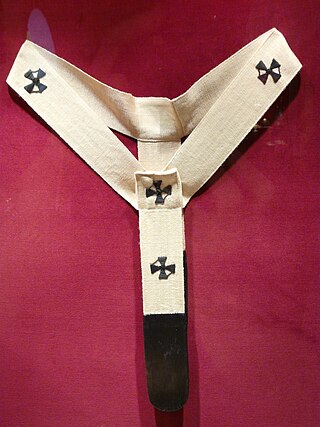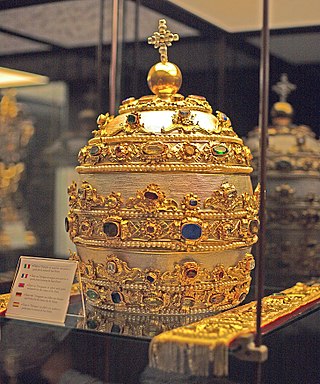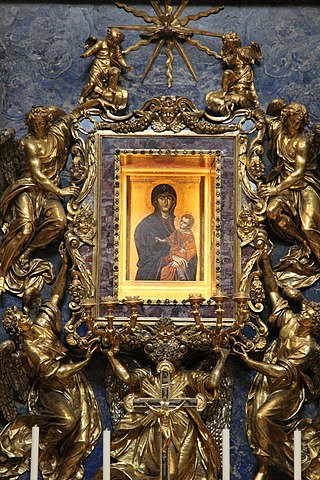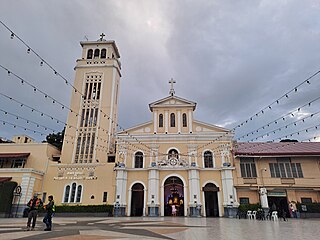| Year | Recipient | Pope | Type of recipient | Geographical area of recipient | Notes |
|---|
| 1096 | Fulk IV, Count of Anjou | Urban II | man | France | [7] |
| 1148 | Alfonso VII, King of León and Castile | Eugene III | man | Spain | |
| 1163 | Louis VII, King of France | Alexander III | man | France | |
| 1183 | William I, King of Scots | Lucius III | man | Scotland | [8] |
| 1227 | Raimondo Orsini | Gregory IX | man | Italy | [9] |
| 1244 | Church of Saint-Just, Lyon | Innocent IV | church | France | [9] |
| 1304 | Church of San Domenico, Perugia | Benedict XI | church | Italy | [9] |
| 1348 | Louis I, King of Naples | Clement VI | man | Italy | |
| 1348 | Louis I, King of Hungary | Clement VI | man | Hungary | [9] |
| 1350 | Niccolò Acciaioli, Grand Seneschal of Naples | Innocent VI | man | Italy | [9] |
| 1362-70 | Valdemar IV of Denmark | Urban V | man | Denmark | [9] |
| 1368 | Joanna I, Queen of Naples | Urban V | woman | Italy | [9] |
| 1369 | St. Peter's Basilica | Urban V | church | Italy | [9] |
| 1389 | Raimondo Del Balzo Orsini | Urban V | man | Italy | [9] |
| 1391 | Alberto d'Este, Marquis of Ferrara | Boniface IX | man | Italy | [9] |
| 1393 | Astorre I Manfredi da Bagnacavallo | Boniface IX | man | Italy | [9] |
| 1398 | Ugolino III Trinci, Lord of Foligno | Boniface IX | man | Italy | [9] |
| 1410 | Niccolò III d'Este, Marquis of Ferrara | Alexander V | man | Italy | [10] |
| 1411 | Charles VI, King of France | John XXIII | man | France | [10] |
| 1413 | Luigi Alidosi, Lord of Imola | John XXIII | man | Italy | [10] |
| 1415 | Sigismund, Holy Roman Emperor | John XXIII | man | Germany | [10] |
| 1419 | Republic of Florence | Martin V | state | Italy | [10] |
| 1420 | Guidantonio da Montefeltro, Count of Urbino | Martin V | man | Italy | [10] |
| 1435 | Sigismund, Holy Roman Emperor | Eugene IV | man | Germany | [10] |
| 1444 | Henry VI, King of England | Eugene IV | man | England | |
| 1448 | Casimir IV, King of Poland | Nicholas V | man | Poland | |
| 1452 | Frederick III, Holy Roman Emperor, and Empress Eleonora | Nicholas V | couple | Germany | received the day after they were crowned |
| 1457 | Charles VII, King of France | Callistus III | man | France | |
| 1461 March 15 | Thomas Palaiologos | Pius II | man | Greece | [11] |
| 1477 | Ludovico III Gonzaga, Marquis of Mantua | Sixtus IV | man | Italy | [12] |
| 1481 | Louis XI of France | Sixtus IV | man | France | [13] |
| 1482 | Eberhard I, Duke of Württemberg | Sixtus IV | man | Germany | |
| 1486 | James III, King of Scotland | Innocent VIII | man | Scotland | |
| 1491 | James IV, King of Scotland | Innocent VIII | man | Scotland | |
| 1493 | Isabella I, Queen of Castile | Alexander VI | woman | Spain | |
| 1505 | Alexander Jagiellon, King of Poland | Julius II | man | Poland | |
| 1506 | Manuel I, King of Portugal | Julius II | man | Portugal | |
| 1514 | Manuel I, King of Portugal | Leo X | man | Portugal | Second award |
| 1518 | Frederick III, Elector of Saxony | Leo X | man | Germany | |
| 1512? | Henry VIII, King of England | Julius II | man | England | |
| 1521? | Henry VIII, King of England | Leo X | man | England | |
| 1524 | Henry VIII, King of England | Clement VII | man | England | |
| 1537 | Federico II Gonzaga, Duke of Mantua | Paul III | man | Italy | [14] because of his kindness towards the Fathers of the Council of Trent |
| 1543 | Ercole II d'Este, Duke of Ferrara | Paul III | man | Italy | [15] |
| 1548 | Catherine de' Medici, Queen of France | Paul III | woman | France | [15] |
| 1550 | João Manuel, Prince of Portugal | Julius III | man | Portugal | [15] |
| 1551 | Basilica di Santa Maria Maggiore | Julius III | church | Italy | [15] |
| 1555 | Mary I, Queen of England | Paul IV | woman | England | [15] |
| 1557 | María Enríquez Álvarez de Toledo, Duchess of Alba de Tormes | Paul IV | woman | Spain | [15] wife of Fernando Álvarez de Toledo y Pimentel, 3rd Duke of Alba de Tormes |
| 1560 | Mary, Queen of Scots | Pius IV | woman | Scotland | |
| 1561 | Anne, Queen of Bohemia | Pius IV | woman | Bohemia | [15] |
| 1564 | Republic of Lucca | Pius IV | state | Italy | [15] |
| 1572 | Charles IX, King of France | Gregory XIII | man | France | given in appreciation of the King's role in enabling St. Bartholomew's Day massacre |
| 1574 March 24 | Don John of Austria | Gregory XIII | man | Spain and Germany | given in the church of St. Clara, Naples, by the Pope's Chamberlain, "in token of his [the Pope's] benevolence and paternal love." [16] |
| 1592 | Henry IV, King of France | Clement VIII | man | France | |
| 1597 | Morosina Morosini | Clement VIII | woman | Venice | given at her coronation as Dogaressa of Venice |
| 1598 | Margaret, Queen of Spain | Clement VIII | woman | Spain | received on the day she was married by proxy to Philip III, King of Spain |
| 1607 | Santa Maria sopra Minerva | Paul V | church | Italy | [17] |
| 1610 | Sancta Sanctorum | Paul V | church | Italy | [17] |
| 1625 | Henrietta Maria, Queen of England and Scotland | Urban VIII | woman | England and Scotland | [17] received at Amiens |
| 1626/7 | Ferdinand II, Grand Duke of Tuscany | Urban VIII | man | Italy | [17] |
| 1628 | Maddalena, Dowager Grand Duchess of Tuscany | Urban VIII | woman | Italy | [17] |
| 1630 | Maria Anna, Queen of Hungary | Urban VIII | woman | Germany | [17] later Empress Consort |
| 1631 | Taddeo Barberini, Prefect of Rome | Urban VIII | man | Italy | [17] he was the pope's nephew |
| 1634 | St. Peter's Basilica | Urban VIII | church | Italy | [17] |
| 1635 | Maria Anna, Electress of Bavaria | Urban VIII | woman | Germany | [18] |
| 1649 | Mariana, Queen of Spain | Innocent X | woman | Spain | [19] |
| 1651? | Marie Louise, Queen of Poland | Innocent X | woman | Poland | [19] |
| 1654 | Lucrezia, Duchess of Modena | Innocent X | woman | Italy | [19] |
| 1658 | Siena Cathedral | Alexander VII | church | Italy | [19] cathedral of the pope's hometown, rose designed by Gian Lorenzo Bernini |
| 1668 | Maria Theresa, Queen of France | Alexander VII | woman | France | for her infant son, the Dauphin, for whom the pope was godfather |
| 1672 | Elenor, Queen of Poland | Clement X | woman | Poland | |
| 1684 March 25 | Marie Casimire Louise, Queen of Poland | Innocent XI | woman | Poland | [20] |
| 1699 | Wilhelmina Amalia, Empress of the Holy Roman Empire | Innocent XII | woman | Germany | |
| 1701 | Maria Luisa, Queen of Spain | Clement XI | woman | Spain | |
| 1726 | Violante Beatrice, Grand Princess of Tuscany | Benedict XIII | woman | Italy | [21] |
| 1736 | Maria Josepha, Queen of Poland | Clement XII | woman | Poland | [22] |
| 1759 | Francesco Loredan, Doge of Venice | Clement XIII | man | Italy | |
| 1776 | Maria Christina, Duchess of Teschen | Pius VI | woman | Austria | |
| 1784 | Maria Amalia, Duchess of Parma | Pius VI | woman | Italy | |
| 1790 | Maria Carolina, Queen of Naples | Pius VI | woman | Italy | |
| 1819 | Caroline Augusta, Empress of Austria | Leo XII | woman | Austria | |
| 1825 | Maria Theresa, Queen Dowager of Sardinia | Leo XII | woman | Italy | |
| 1830 | Cathedral of Cingoli | Pius VIII | church | Italy | [23] cathedral of the pope's hometown |
| 1832 | Maria Anna, Queen of Hungary | Gregory XVI | woman | Austria | [23] later Empress Consort of Austria |
| 1833 | St Mark's Basilica | Gregory XVI | church | Italy | [23] |
| 1842 | Maria II, Queen of Portugal | Gregory XVI | woman | Portugal | |
| 1849 | Princess Maria Pia of Savoy | Pius IX | woman | Italy | given by her godfather on the day of her baptism; later Queen Consort of Portugal |
| 1856 | Eugenie, Empress of the French | Pius IX | woman | France | |
| 1861 | Maria Sophie, Queen of the Two Sicilies | Pius IX | woman | Italy | |
| 1868 | Elisabeth, Empress of Austria | Pius IX | woman | Austria | |
| 1868 | Isabella II, Queen of Spain | Pius IX | woman | Spain | |
| 1870 | Sant'Antonio dei Portoghesi | Pius IX | church | Italy | [24] |
| 1877 Sep. | Sanctuary of Our Lady of Lourdes | Pius IX | shrine | France | [25] |
| 1886 | Maria Christina, Queen Dowager of Spain | Leo XIII | woman | Spain | |
| 1887 | Mary Gwendoline Caldwell | Leo XIII | woman | United States | Mrs. Caldwell had donated money towards the founding of the Catholic University of America [26] [27] |
| 1888 | Isabel, Princess Imperial of Brazil | Leo XIII | woman | Brazil | see Lei Áurea |
| 1892 | Amélie, Queen of Portugal | Leo XIII | woman | Portugal | |
| 1893 | Marie Henriette, Queen of the Belgians | Leo XIII | woman | Belgium | |
| 1923 | Victoria Eugenie, Queen of Spain | Pius XI | woman | Spain | |
| 1926 | Elisabeth, Queen of the Belgians | Pius XI | woman | Belgium | |
| 1930 | Elena, Queen of Italy | Pius XI | woman | Italy | [28] |
| 1937 | Elena, Queen of Italy | Pius XI | woman | Italy | [29] in observance of her 40th wedding anniversary |
| 1953 | Se Cathedral | Pius XII | church | India | [30] placed on the tomb of Francis Xavier |
| 1956 | Charlotte, Grand Duchess of Luxembourg | Pius XII | woman | Luxembourg | |
| 1964 | Church of the Nativity | Paul VI | church | Palestine | [31] |
| 1965 | Sanctuary of Our Lady of Fátima | Paul VI | shrine | Portugal | [32] |
| 1966 March 25 | Basilica of Our Lady of Guadalupe | Paul VI | church | Mexico | [30] |
| 1967 | Basilica of Our Lady Aparecida (now known as the "Old Basilica of Aparecida") | Paul VI | church | Brazil | [30] |
| 1979 June | Black Madonna of Częstochowa | John Paul II | shrine | Poland | [33] |
| 1979 Sep. | Knock Shrine | John Paul II | shrine | Ireland | [34] |
| 1982 June | Basilica of Our Lady of Luján | John Paul II | shrine | Argentina | [35] [36] [37] |
| 1985 June 28 | Basilica of Assumption of Mary and Saints Cyril and Methodius in Velehrad | John Paul II | shrine | Czech Republic | [38] [39] |
| 1987 June | Kalwaria Zebrzydowska | John Paul II | shrine | Poland | [40] |
| 1988 May 14 | Sanctuary of Our Lady of the Evangelization | John Paul II | shrine | Lima, Peru | [41] |
| 2000 Dec. | Holy House of Loreto | John Paul II | shrine | Italy | |
| 2004 Aug. 14 | Sanctuary of Our Lady of Lourdes | John Paul II | shrine | France | [42] Second award |
| 2004 Oct. 17 | Saint Joseph's Oratory | John Paul II | church | Montreal, Canada | [43] |
| 2004 Dec. | Sameiro Sanctuary | John Paul II | shrine | Braga, Portugal | [44] |
| 2006 | Black Madonna of Częstochowa | Benedict XVI | shrine | Poland | Second award |
| 2007 May 12 | Basilica of the National Shrine of Our Lady Aparecida ("New Basilica of Aparecida") | Benedict XVI | shrine | Brazil | Second award to the image of Our Lady Aparecida. The first award was given to the image in 1967 when it was housed in the Old Basilica, before the construction and consecration of the new Basilica in 1980. [45] |
| 2007 Sep. 8 | Basilica of the Birth of the Virgin Mary Mariazell | Benedict XVI | shrine | Austria | [46] [47] |
| 2008 Apr. 9 | Shrine of Our Lady of Altötting | Benedict XVI | shrine | Altötting, Germany | [48] |
| 2008 Apr. 16 | Basilica of the National Shrine of the Immaculate Conception | Benedict XVI | shrine | Washington D.C., USA | [49] |
| 2008 May 17 | Sanctuary of Nostra Signora della Misericordia | Benedict XVI | shrine | Savona, Italy | [50] |
| 2008 May 18 | Shrine of Nostra Signora della Guardia | Benedict XVI | shrine | Genoa, Italy | [50] |
| 2008 Sep. 7 | Shrine of Our Lady of Bonaria | Benedict XVI | shrine | Cagliary, Italy | [50] |
| 2008 Oct. 19 | Shrine of the Virgin of the Rosary of Pompei | Benedict XVI | shrine | Pompei, Italy | [51] [52] |
| 2009 Apr. 28 | Shrine of Our Lady of the Cross | Benedict XVI | shrine | Aquila, Italy | after the earthquake [53] |
| 2009 May | Shrine of Our Lady of Europe | Benedict XVI | shrine | Gibraltar | [54] [55] |
| 2009 Nov. 22 | Basilica of Nuestra Señora de la Cabeza | Benedict XVI | shrine | Jaén, Spain | [50] |
| 2010 | Catedral Basílica de Nuestra Señora del Valle | Benedict XVI | church | Argentina | [37] [56] |
| 2010 Apr. 18 | Shrine of Our Lady of Ta' Pinu | Benedict XVI | shrine | Malta | [57] |
| 2010 May 12 | Sanctuary of Our Lady of Fátima | Benedict XVI | shrine | Portugal | Second award [58] [59] |
| 2010 Aug. 23 | Sanctuary of Our Lady of the Valley | Benedict XVI | shrine | Catamarca, Argentina | [60] |
| 2010 Nov. 13 | Virgen of Socorro | Benedict XVI | shrine | Valencia, Venezuela | [61] |
| 2011 May 15 | Basilica of Our Lady of Scherpenheuvel | Benedict XVI | shrine | Belgium | [62] |
| 2012 March 26 | Basílica Santuario Nacional de Nuestra Señora de la Caridad | Benedict XVI | church | Cobre, Cuba | [63] [64] |
| 2013 Nov. 22 | Basilica of Our Lady of Guadalupe | Francis | shrine | Mexico | [65] Second award |
| 2015 June 21 | Santuario della Consolata | Francis | shrine | Italy | [66] Given during the pope's visit during the public showing of the Shroud of Turin |
| 2016 July 28 | Black Madonna of Częstochowa | Francis | shrine | Poland | [67] Third Award |
| 2017 May 13 | Sanctuary of Our Lady of Fátima | Francis | shrine | Portugal | Third Award [68] |
| 2017 October 7 | Basilica of the National Shrine of Our Lady Aparecida ("New Basilica of Aparecida") | Francis | shrine | Brazil | Third award of the Golden Rose to the icon of Our Lady Aparecida; second award since the icon was transferred from the Old Basilica to the new Basilica. This award commemorates the 300 anniversary of the icon's appearance and of devotion to it. [69] |
| 2019 June 1 | Our Lady of Csíksomlyó | Francis | shrine | Transylvania, Romania | [70] |
| 2021 September 15 | Basilica of Our Lady of Sorrows | Francis | shrine | Slovakia | [71] |
| 2023 December 8 | Salus Populi Romani | Francis | icon | Italy | [72] |
| 2024 February 26 | Our Lady of Peace and Good Voyage | Francis | shrine/statue | Philippines | Gifted in thanksgiving for the erection of the Antipolo Cathedral as an International Shrine. [73] |
|























